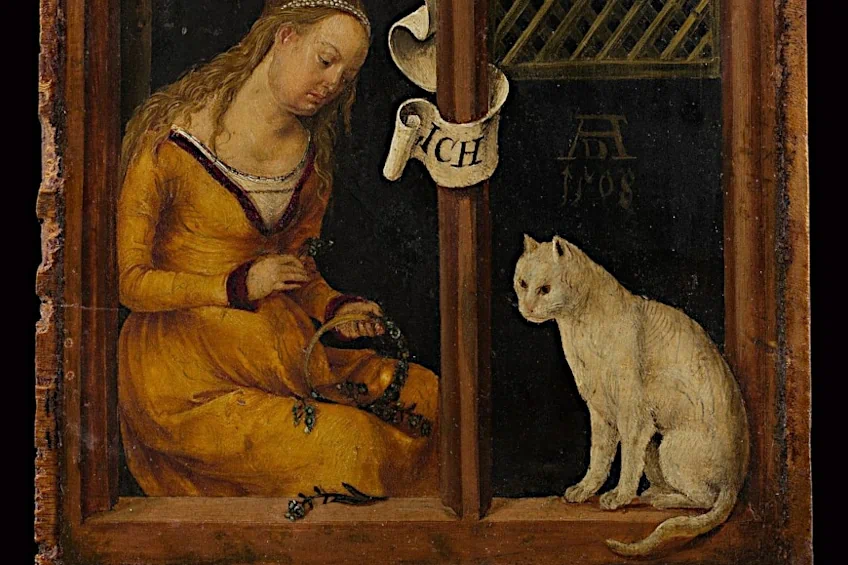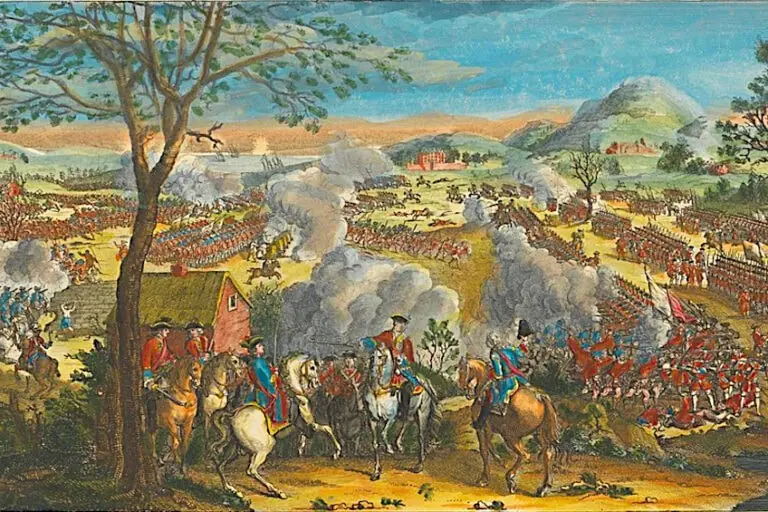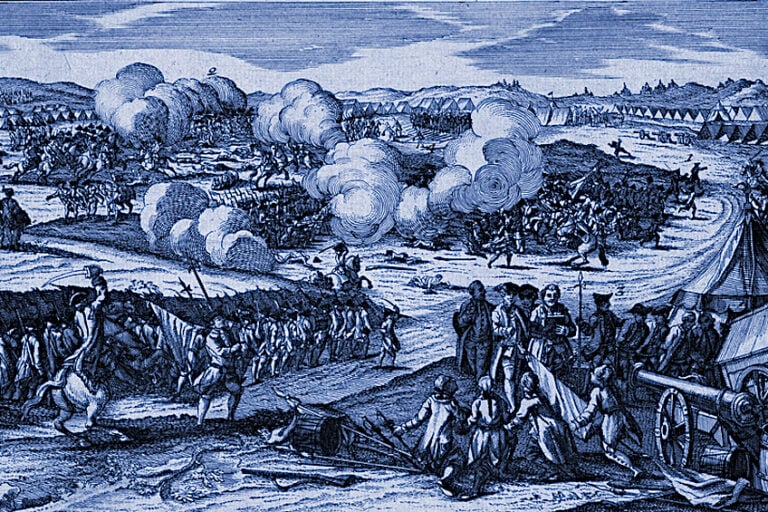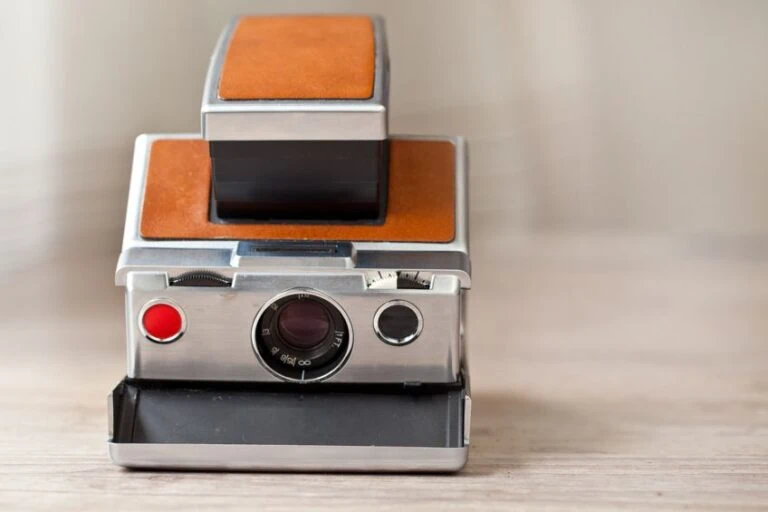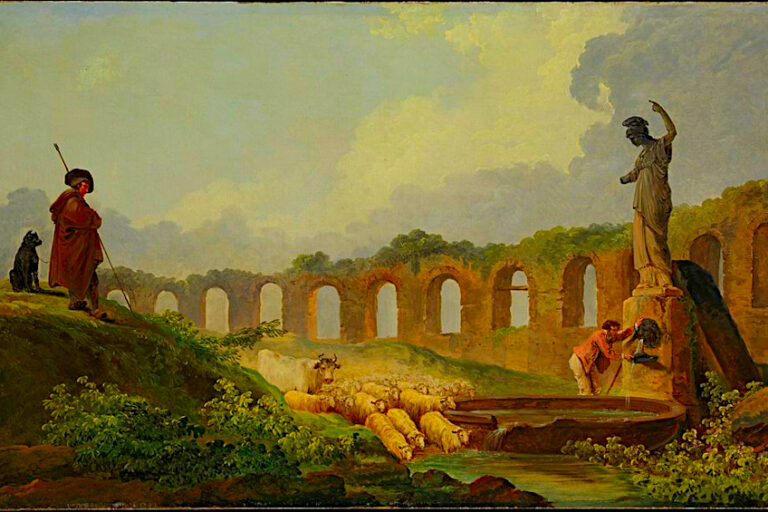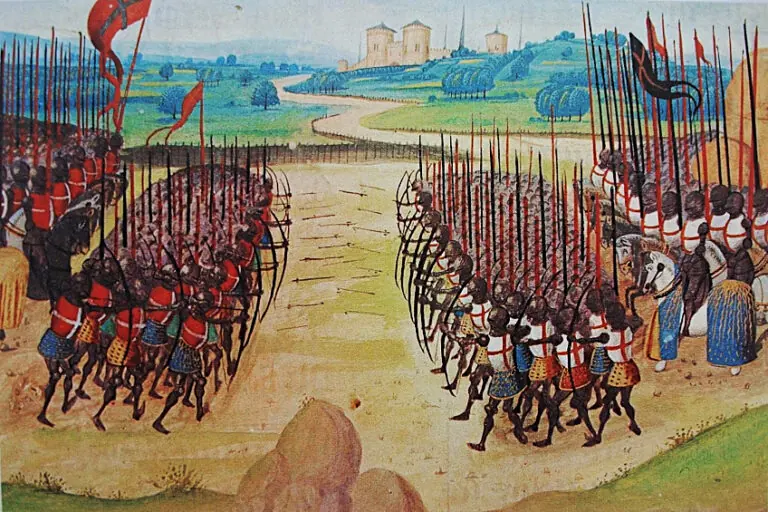Medieval Cat Paintings – Famous Felines from Art History
When you think of art depicting cats, the first thing that probably comes to mind is ancient Egyptian art. Although cats have been popular subjects of painting for thousands of years, it is interesting to note how popular they were during the medieval period (c. 476 AD – c. 1450), also known as the Middle Ages. From the ugly to the comical, these cats were depicted in many ways and can be found in art across many cultures. Below, we list some of the most famous Medieval cat paintings for you to explore!
Contents
- 1 Cats During the Medieval Period
- 2 10 Famous Medieval Cat Paintings and Renaissance Paintings of Cats
- 2.1 Cat Bestiary Illustration (c. 1225 – 1250) by Unknown Artist
- 2.2 Cat and Vielle (c. 1320 – c. 1330) in a Book of Hours by an Unknown Artist
- 2.3 Hissing or Grinning Cat Illustration (c. 1434) by Konrad von Megenberg
- 2.4 Last Supper (c. 1486) by Domenico Ghirlandaio
- 2.5 The Spinner and the Visitor (c. 1495/1503) by Israhel van Meckenem
- 2.6 Adam and Eve (1504) by Albrecht Dürer
- 2.7 Girl Making a Garland (c. 1508) by Hans Süss von Kulmbach
- 2.8 Portrait of a Young Lady Holding a Cat (c. 1525) by Antonio D’Ubertino Verdi
- 2.9 Portrait of Cleophea Krieg von Bellikon (c. 1538) by Hans Asper
- 2.10 The Earl of Southampton (c. 1603) by John de Critz
- 3 Frequently Asked Questions
Cats During the Medieval Period
The ancient Egyptians held great respect for cats, as they were considered sacred. They included them in relief sculpture, papyri, tomb decorations, and the image of the cat even represented Bastet, the feline god of Egypt. During the medieval period, however, this was a different story. Due to their connection with witchcraft and paganism, cats were not seen in a favorable light by the Catholic Church. Cats were often chased from cities as a result, and some were even abused and tortured. However, despite their unfavorable status, cats still formed part of everyday life in Europe, as they provided pest control and found their way into medieval art.
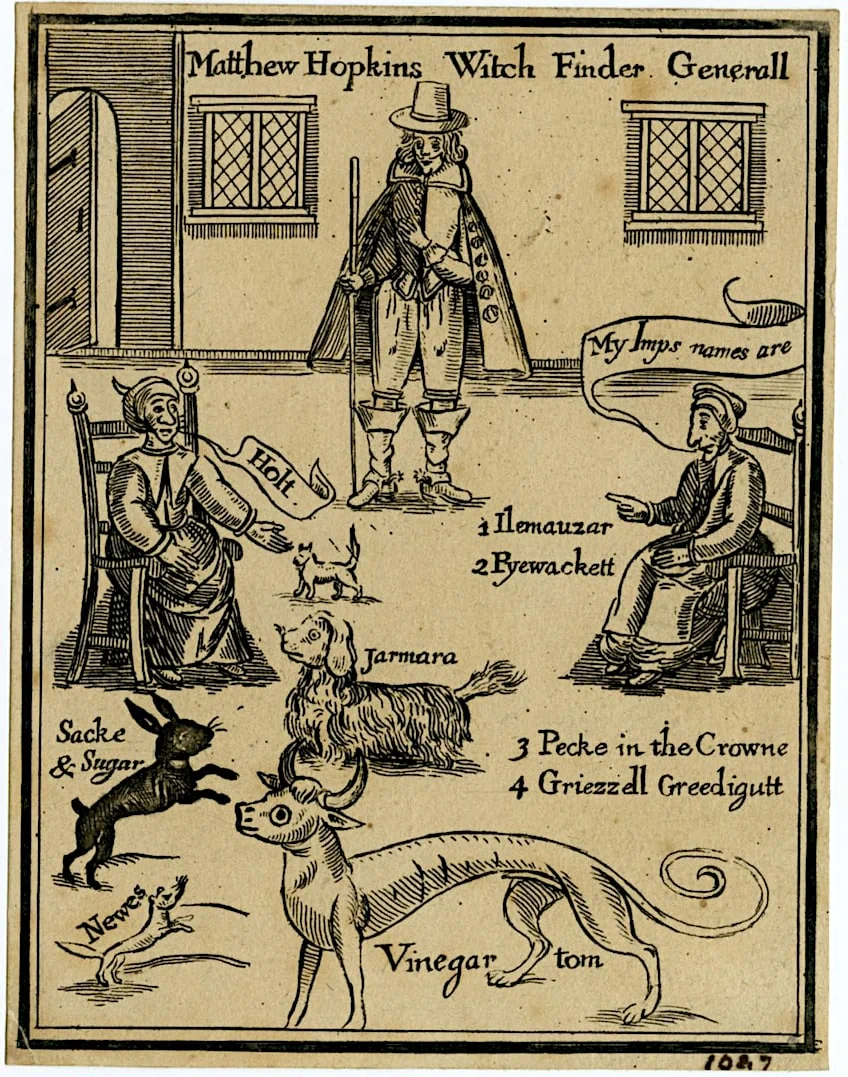 Frontispiece depicting Matthew Hopkins Witch Finder Generall from The Discovery of Witches (1647) shows two suspected witches with their animal “familiars” including a cat closest to the figure on the left; British Museum, Public domain, via Wikimedia Commons
Frontispiece depicting Matthew Hopkins Witch Finder Generall from The Discovery of Witches (1647) shows two suspected witches with their animal “familiars” including a cat closest to the figure on the left; British Museum, Public domain, via Wikimedia Commons
The portrayal of cats in medieval art are not known for their accuracy, and older depictions of cats are famous for looking quite strange. This may be due to their poor reputation during this period. Another reason may be unfamiliarity. Although the Romans introduced domesticated cats into their European colonies, these animals remained relatively rare in Europe. The feline population only underwent a significant increase during the late 13th century. This means that most people, including artists, were not as deeply familiar with feline features as we are today.
10 Famous Medieval Cat Paintings and Renaissance Paintings of Cats
There are many interesting paintings with cats and it would be impossible to list them all in this article, but we have listed ten famous medieval paintings of cats. During the renaissance period (14th – 17th century AD), cats were part of the artistic subject matter as well, and since these two periods overlap, we will be looking at early Renaissance paintings of cats as well.
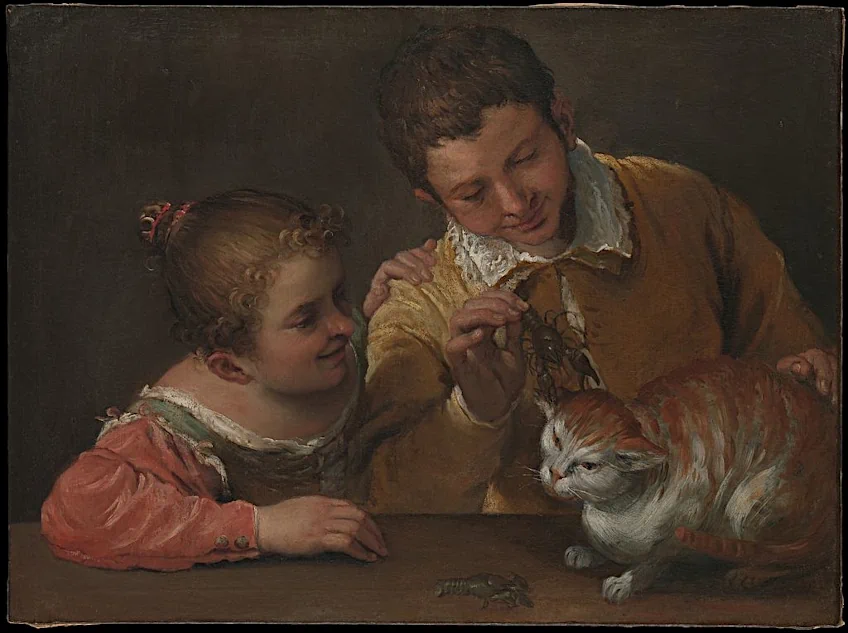 Two Children Teasing a Cat by Annibale Caracci (between 1588 and 1590); Annibale Carracci, Public domain, via Wikimedia Commons
Two Children Teasing a Cat by Annibale Caracci (between 1588 and 1590); Annibale Carracci, Public domain, via Wikimedia Commons
Cat Bestiary Illustration (c. 1225 – 1250) by Unknown Artist
| Artist | Unknown |
| Artwork Title | Cat Bestiary Illustration |
| Date Completed | c. 1225 – 1250 |
| Dimensions (cm) | N/A |
| Medium | Illustration |
| Where It Is Currently Housed | Oxford, Bodleian Library, England |
This illustration from Oxford, Bodleian Library, MS Bodley 764, depicts three cats against a dark blue background with crescent moons and yellow stars, possibly alluding to the ability of cats to see in the dark. One cat is sleeping on the bottom left while another cat is trying to get to a bird sitting in a cage above. A third white cat in the foreground has just caught a mouse or rat.
A bestiary was an encyclopedia of beasts (animals) and was a popular type of illuminated text during the Middle Ages in Northern Europe. Because medieval Christians saw everything in the world as related to God, bestiaries emphasized the religious meaning of each animal. Some people viewed images of a cat chasing a rodent as a reference to the devil pursuing the human soul.
Cat and Vielle (c. 1320 – c. 1330) in a Book of Hours by an Unknown Artist
| Artist | Unknown |
| Artwork Title | Cat and Vielle |
| Date Completed | c. 1320 – 1330 |
| Dimensions (cm) | N/A |
| Medium | Manuscript |
| Where It Is Currently Housed | The Harley Collection, London, England |
This detail of a cat playing a vielle (c. 1320-c. 1330) is one of many animals depicted in the margins of the fragmentary Book of Hours playing instruments. Cats were painted in the margins of many medieval illuminated manuscripts and depicted performing human-like activities. Many of them, like the cat featured here, looked quite strange, and some even grotesque.
Hissing or Grinning Cat Illustration (c. 1434) by Konrad von Megenberg
| Artist | Konrad von Megenberg (1309 – 1374) |
| Artwork Title | Hissing or Grinning Cat |
| Date Completed | c. 1434 |
| Dimensions (cm) | N/A |
| Medium | Woodcut illustration |
| Where It Is Currently Housed | Bibliothèque nationale et universitaire (National University Library), Strasbourg, France |
This illustration is from the Das Buch der Natur (Book of Nature) by Konrad von Megenberg (1309-1374), a German translation of the medieval Latin compilation of natural history. The cat in this work is almost freakishly depicted, with its round shallow eyes and pink lips pulled back in what may be a hiss. However, compared to many medieval paintings of cats, this one is quite realistic.
Last Supper (c. 1486) by Domenico Ghirlandaio
| Artist | Domenico Ghirlandaio (1448 – 1494) |
| Artwork Title | Last Supper |
| Date Completed | c. 1486 |
| Dimensions (cm) | 400 x 800 |
| Medium | Fresco |
| Where It Is Currently Housed | San Marco, Florence, Italy |
Last Supper (c. 1486) by the Florentine painter, Domenico Ghirlandaio (1448 – 1494) depicts the last supper with Jesus and the apostles sitting at a long table. Judas is the odd one out as he sits across from Jesus on the opposite side of the table on a stool with three legs, possibly representing the holy trinity. On the floor behind him sits a cat. Although its body faces Judas, the cat’s head is turned to look directly at the viewer.
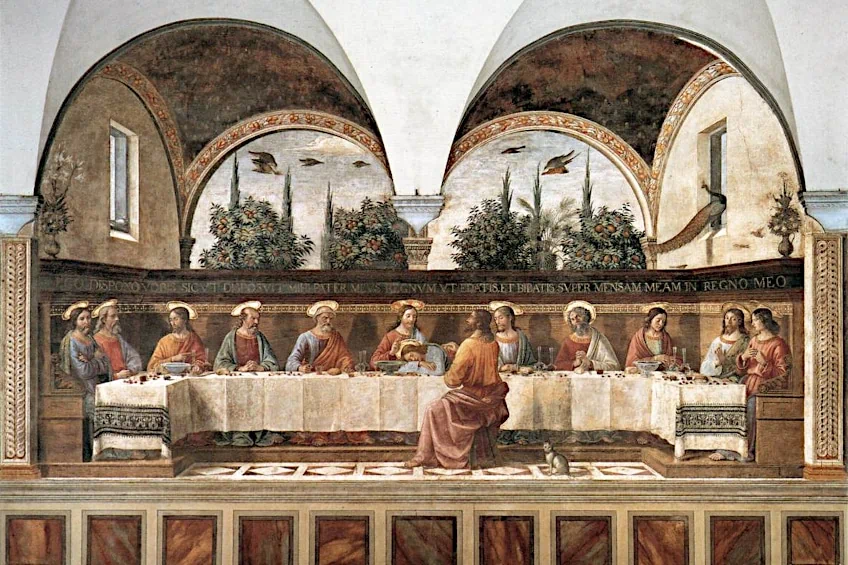 The Last Supper by Domenico Ghirlandaio (c. 1486); Domenico Ghirlandaio, Public domain, via Wikimedia Commons
The Last Supper by Domenico Ghirlandaio (c. 1486); Domenico Ghirlandaio, Public domain, via Wikimedia Commons
The cat behind Judas may have a double meaning. On a superficial level, the cat, waiting for any scraps of food that may happen to pass its way brings a feeling of domesticity and intimacy to the setting. However, it may symbolize the treason committed by Judas and the influence of evil. Its foreboding gaze towards the viewer reminds us that like Judas and Jesus we (the viewers) already know what will happen next.
Considering that this fresco was painted for Dominican Monks who played a role as judges in the inquisition and therefore, had a hand in the deaths of suspected witches, the cat being a symbol of evil may not be far off.
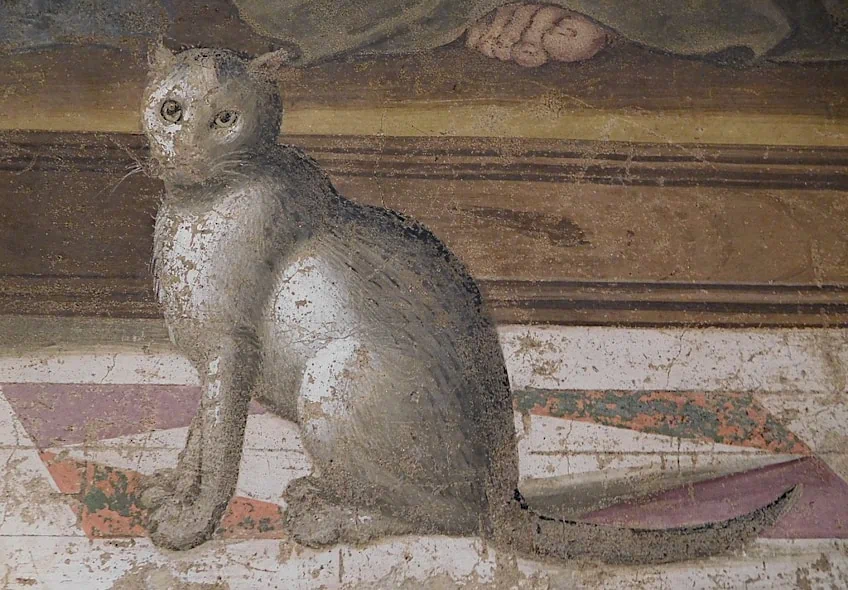 Detail of the cat in the Last Supper fresco by Domenico Ghirlandaio (c. 1486); Ian Alexander; painter: Domenico Ghirlandaio, Public domain, via Wikimedia Commons
Detail of the cat in the Last Supper fresco by Domenico Ghirlandaio (c. 1486); Ian Alexander; painter: Domenico Ghirlandaio, Public domain, via Wikimedia Commons
The Spinner and the Visitor (c. 1495/1503) by Israhel van Meckenem
| Artist | Israhel van Meckenem (c.1445 – 1503) |
| Artwork Title | The Spinner and the Visitor |
| Date Completed | 15th century |
| Dimensions (cm) | 16.2 x 11.1 |
| Medium | Engraving |
| Where It Is Currently Housed | National Gallery of Art, Washington, United States |
The engraving, The Spinner and the Visitor (15th century) by the German artist, Israhel van Meckenem (c.1445-1503) depicts a male visitor sitting on a stool in front of a female figure who is in the process of spinning material. The male figure holds his sword suggestively between his legs as he looks at the woman, who may be a prostitute.
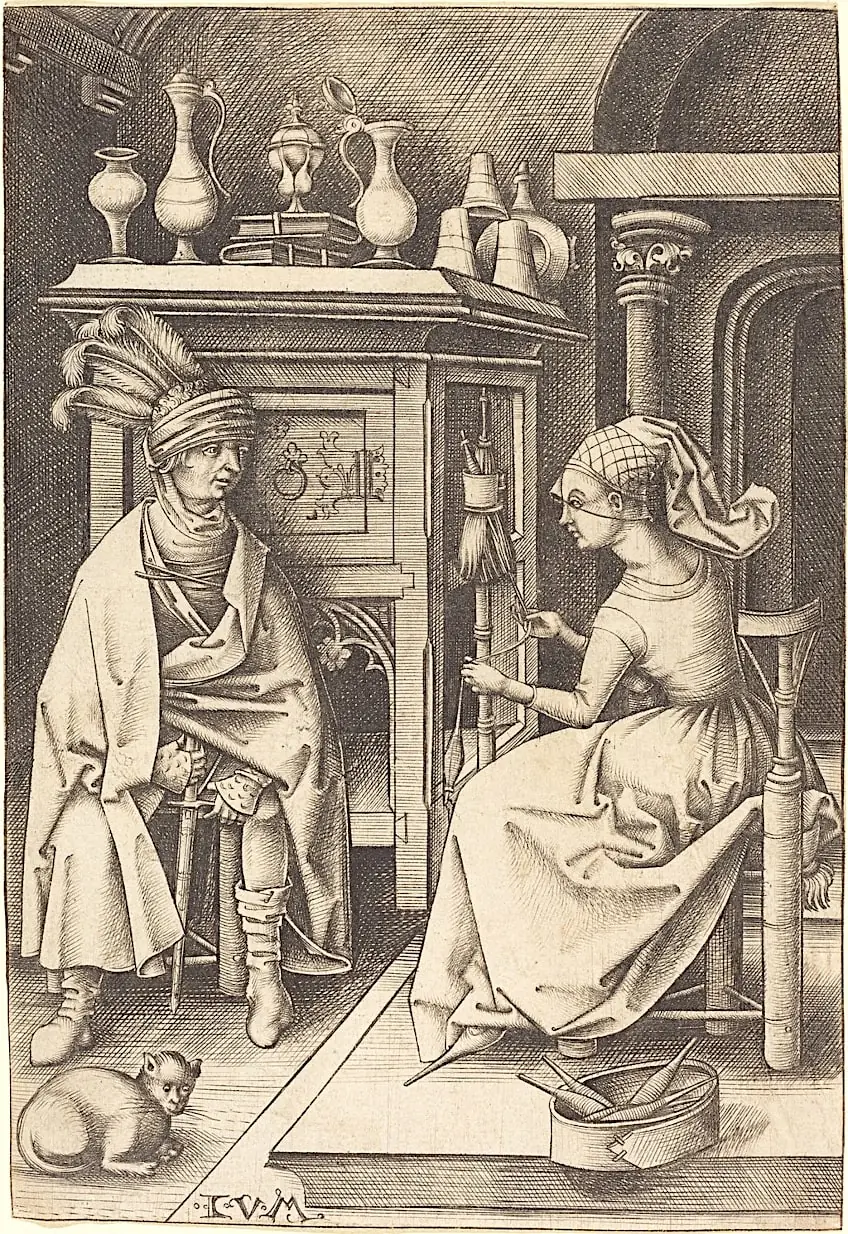 The Visit to the Spinner by Israhel van Meckenem (c. 1495/1503); National Gallery of Art, CC0, via Wikimedia Commons
The Visit to the Spinner by Israhel van Meckenem (c. 1495/1503); National Gallery of Art, CC0, via Wikimedia Commons
The cat sitting on the floor in the bottom left-hand corner of the picture is a symbol of temptation. The cat does not look like your regular cat, having a head that could be described as similar to a monkey’s or a bat’s. This may represent the ugly nature of provocative solicitation during the time.
Adam and Eve (1504) by Albrecht Dürer
| Artist | Albrecht Dürer (1471 – 1528) |
| Artwork Title | Adam and Eve |
| Date Completed | 1504 |
| Dimensions (cm) | 25.1 x 20 |
| Medium | Engraving |
| Where It Is Currently Housed | The Metropolitan Museum of Art, New York City, United States |
This engraving of Adam and Eve (1504) by the German artist, Albrecht Dürer (1471-1528) depicts Eve as she accepts the forbidden fruit from Satan. Next to her under the tree stands Adam, and they are both surrounded by wilderness and various animals that represent medieval notions of the temperaments.
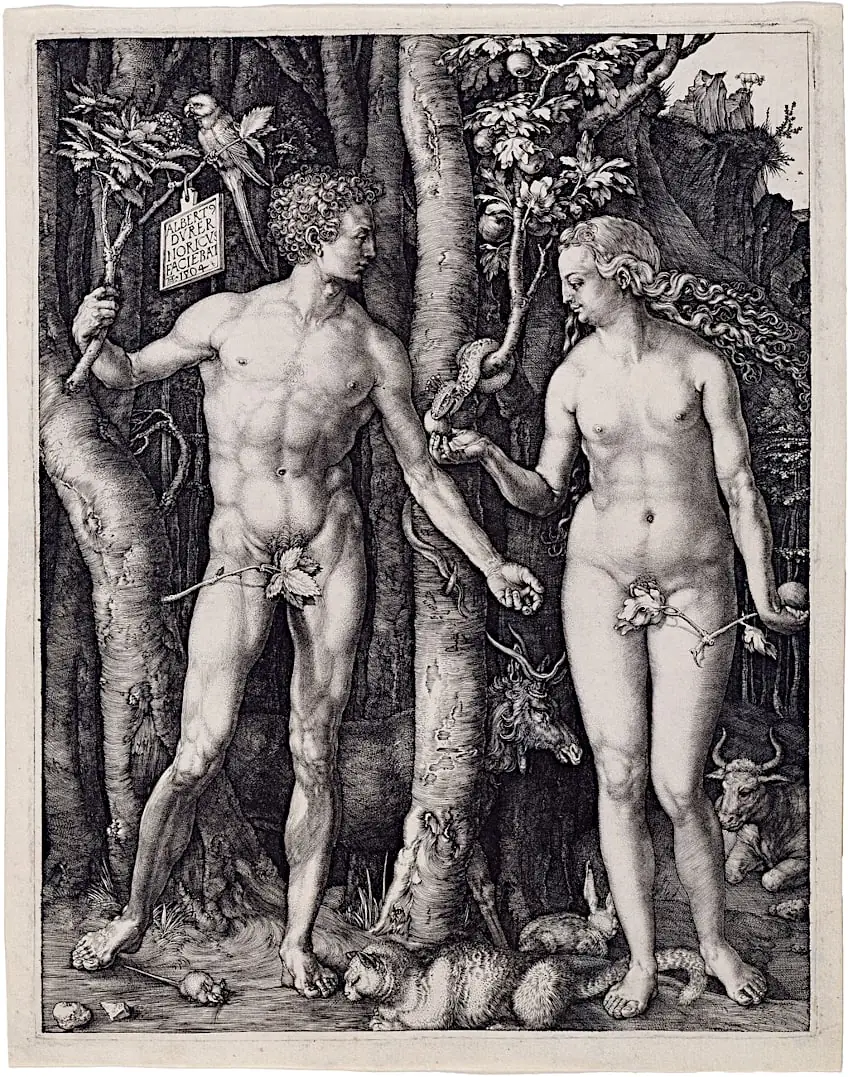 Adam and Eve by Albrecht Dürer (1504); Albrecht Dürer, Public domain, via Wikimedia Commons
Adam and Eve by Albrecht Dürer (1504); Albrecht Dürer, Public domain, via Wikimedia Commons
The cat that sits on the ground between Adam and Eve represents choleric, the trait of being easily irritated or bad-tempered. In the context of the Temptation it may also refer to a sense of dissatisfaction with their lives in the garden that may have played a role in Adam and Eve’s willingness to eat the forbidden fruit.
Girl Making a Garland (c. 1508) by Hans Süss von Kulmbach
| Artist | Hans Süss von Kulmbach (1480 – c.1522) |
| Artwork Title | Girl Making a Garland |
| Date Completed | ca. 1508 |
| Dimensions (cm) | 17.8 x 14 |
| Medium | Oil on wood |
| Where It Is Currently Housed | The Metropolitan Museum of Modern Art, New York City, United States |
This painting by the German artist, Hans Süss von Kulmbach (1480 – c.1522) is special in that it consists of two paintings: the Portrait of a Young Man (ca. 1508) on the front with the allegorical Girl Making a Garland (ca. 1508) on the reverse. For this article, we will be focusing on the reverse panel, which depicts a girl using forget-me-nots to make a garland while a white cat sits on the windowsill in front of her. A trailing banderole floating above the figure’s head translates to “I bind with forget-me-nots”.
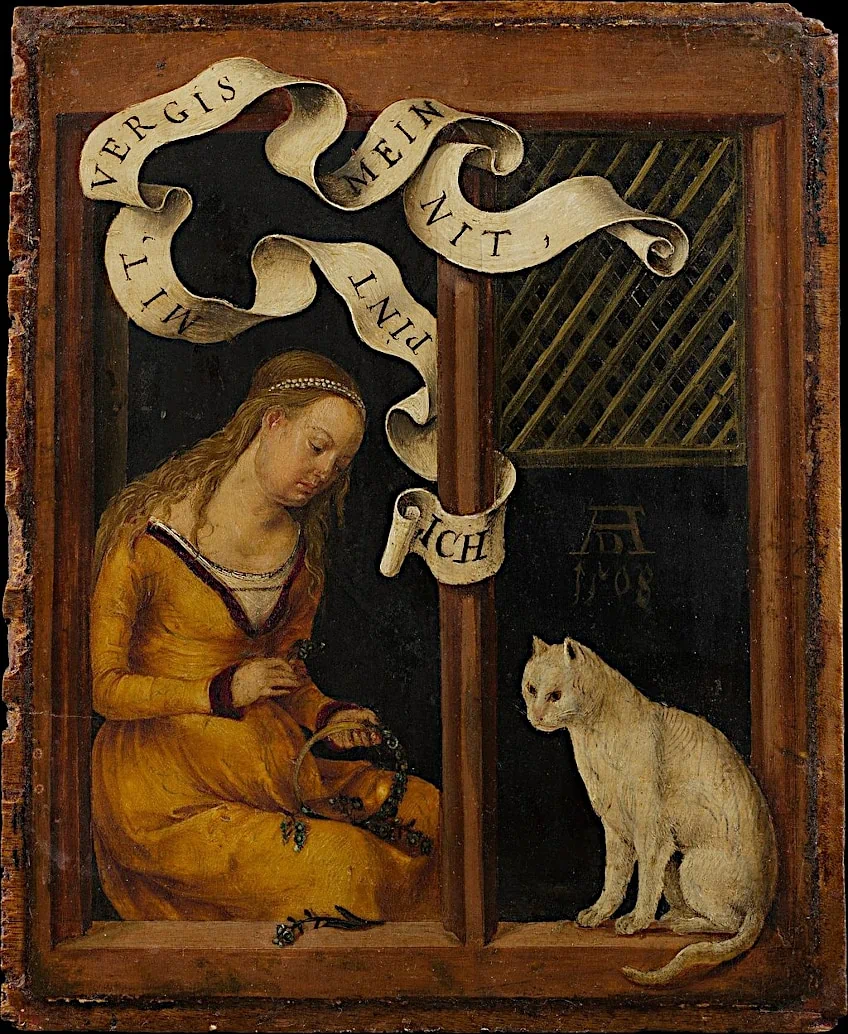 Girl Making a Garland (reverse side of the panel with Portrait of a Young Man) by Hans von Kulmbach (c. 1508); Hans von Kulmbach, CC0, via Wikimedia Commons
Girl Making a Garland (reverse side of the panel with Portrait of a Young Man) by Hans von Kulmbach (c. 1508); Hans von Kulmbach, CC0, via Wikimedia Commons
She is a symbolic promise of love to the male figure on the other side of the painting. The white cat sitting on the windowsill is prominently placed and refers to her affection and commitment, a symbol of constant love.
Portrait of a Young Lady Holding a Cat (c. 1525) by Antonio D’Ubertino Verdi
| Artist | Antonio D’Ubertino Verdi (1499 – 1572) |
| Artwork Title | Portrait of a Young Lady Holding a Cat |
| Date Completed | c. 1525 |
| Dimensions (cm) | 53 x 44 |
| Medium | Oil on panel |
| Where It Is Currently Housed | Christie’s Auction House, New York City, United States |
This painting by the Italian artist, Antonio D’Ubertino Verdi (1499-1572) depicts a wealthy young woman holding a cat in her arms close to her chest. This Portrait of a Young Lady Holding a Cat (1525) is different from other paintings of cats in the same period in that the cat is rendered in a more realistic manner.
As the woman looks toward the viewer, the cat in her arms characteristically has its attention on something else in the room.
Portrait of Cleophea Krieg von Bellikon (c. 1538) by Hans Asper
| Artist | Hans Asper (1499 – 1571) |
| Artwork Title | Portrait of Cleophea Krieg von Bellikon |
| Date Completed | 1538 |
| Dimensions (cm) | 77 x 61 |
| Medium | Oil on canvas |
| Where It Is Currently Housed | Kunsthaus Zurich, Zurich, Switzerland |
The Portrait of Cleophea Krieg von Bellikon (c. 1538) by the Swiss portraitist, Hans Asper (1499-1571) is quite comical as it depicts a wealthy woman sitting with her pet cat on her lap and her dog below on the left of the picture.
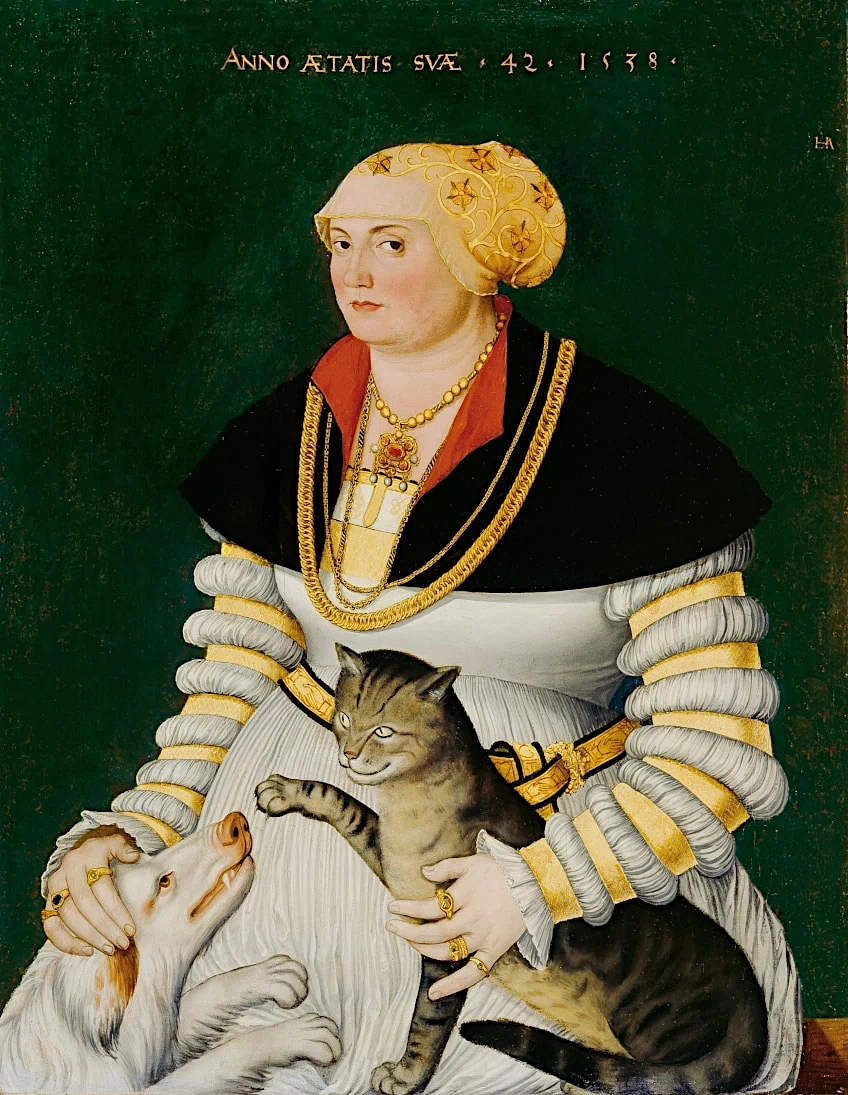 Portrait of Cleophea Krieg von Bellikon by Hans Asper (1538); Hans Asper, Public domain, via Wikimedia Commons
Portrait of Cleophea Krieg von Bellikon by Hans Asper (1538); Hans Asper, Public domain, via Wikimedia Commons
The dog has its paws on the woman’s dress, reaching towards the cat, which has its paw raised in a threatening manner with its claws out. The dog appears to be snarling at the feline which is portrayed with a bemused or even sly expression as it looks down at the dog. The woman has a hand on each animal as she looks towards the viewer.
The Earl of Southampton (c. 1603) by John de Critz
| Artist | John de Critz (1551 – 1642) |
| Artwork Title | The Earl of Southampton |
| Date Completed | c. 1603 |
| Dimensions (cm) | 45 x 60 |
| Medium | Oil painting |
| Where It Is Currently Housed | Broughton House, Northamptonshire, England |
The Earl of Southampton (1603) by John de Critz (1551-1642) depicts the second Earl of Southampton’s only son, Henry Wriothesley, to whom Shakespeare dedicated two of his narrative works. Wriothesley’s black and white cat, Trixie sits next to him in front of a window with a comical expression of both annoyance and interest.
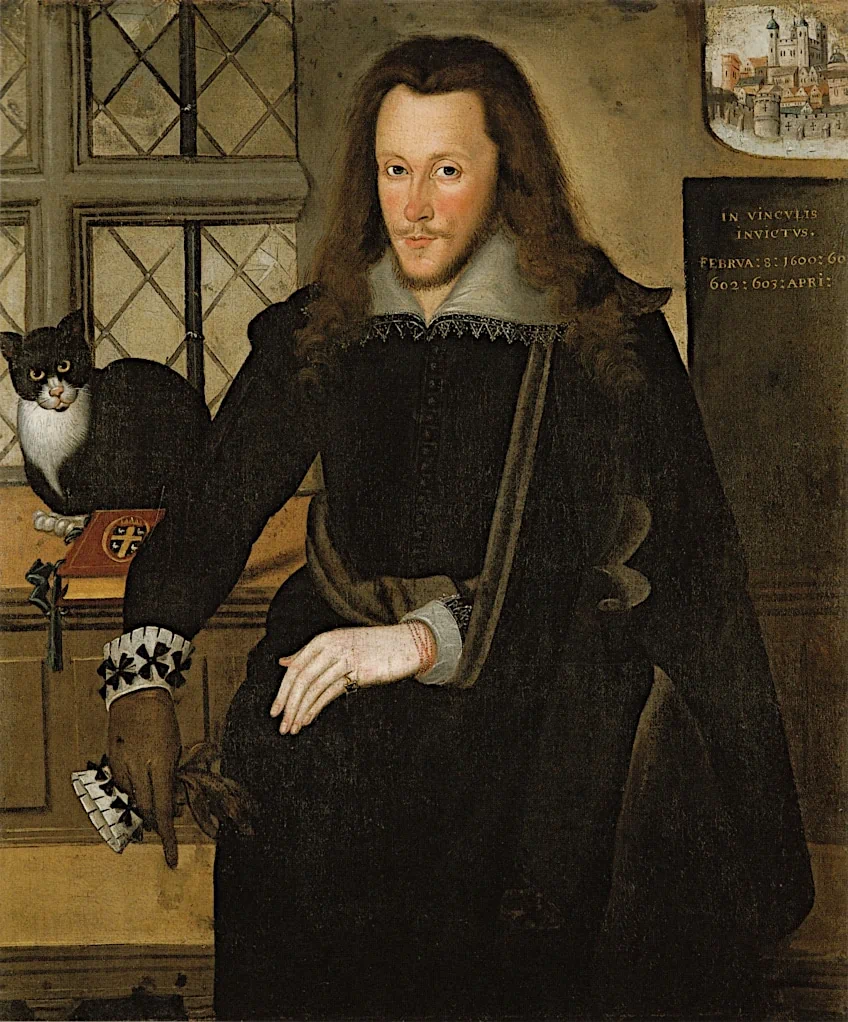 The Earl of Southampton attributed to John de Critz (c. 1603); Attributed to John de Critz, Public domain, via Wikimedia Commons
The Earl of Southampton attributed to John de Critz (c. 1603); Attributed to John de Critz, Public domain, via Wikimedia Commons
That concludes our article on medieval cat paintings and renaissance cat paintings. Cats were not often the main feature of these artworks, but despite this, they were intentionally placed and given meaning and symbolism. Although they carried with them connotations of evil and temptation amongst other things, this view softened as time passed into the renaissance and beyond. It is interesting to see how one animal can carry so much weight!
Frequently Asked Questions
What Does the Symbol of the Cat Mean in Medieval Art?
Due to their connection with witchcraft and paganism, cats were not seen in a favorable light by the Catholic church, and therefore were often associated with temptation and evil. However, this stigma softened somewhat during the renaissance period and changed the representation of cats in renaissance cat paintings.
Why Did Cats in Medieval Paintings Look So Weird?
The portrayal of cats in medieval art are not known for their accuracy and are famous for looking quite strange. This may be due to their poor reputation during this period as being associated with evil and other negative connotations. Another reason may be unfamiliarity: while the Romans had introduced domesticated cats into their European colonies, these animals were relatively rare in Central Europe before a significant increase in feline population during the late 13th century. This means that most people, including artists, were not as familiar with feline features as we are today. Also most of these cats served as pest control and were too feral to sit still for an artist painting their portrait.

I am deeply passionate about history and am constantly fascinated by the rich and complex stories of the past. As the editor-in-chief of learning-history.com, I have the opportunity to share this passion with a wide audience through the creation and distribution of engaging and informative content about historical events, persons, and cultures. Whether it’s through writing articles and blog posts or creating videos or podcasts, I strive to bring the past to life in a way that is both accurate and enjoyable. My expertise in history, combined with my strong writing and communication skills, allows me to effectively communicate complex historical concepts and make them accessible and interesting to a wide range of readers. I am truly grateful for the opportunity to share my love of history with others through my work on learning-history.com.

